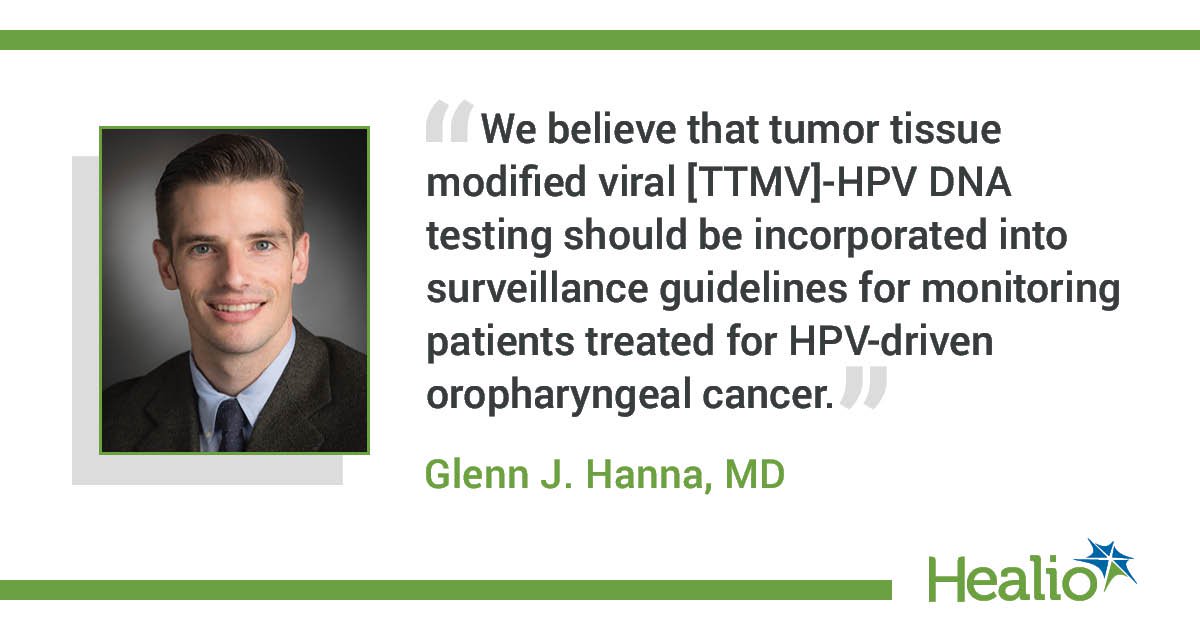Author: Ryan Lawrence
Source: www.healio.com
A blood test to detect circulating tumor DNA accurately predicted recurrence of HPV-driven oropharyngeal cancer after treatment, according to research presented at Multidisciplinary Head and Neck Cancers Symposium.
In addition, findings from the retrospective clinical case series suggested the biomarker test may detect disease recurrence earlier than imaging or other surveillance methods, allowing clinicians to personalize treatment faster for patients whose cancer returns.
“We believe that tumor tissue modified viral [TTMV]-HPV DNA testing should be incorporated into surveillance guidelines for monitoring patients treated for HPV-driven oropharyngeal cancer,” Glenn J. Hanna, MD, director of the Center for Salivary and Rare Head and Neck Cancers at Dana-Farber Cancer Institute and assistant professor of medicine at Harvard Medical School, told Healio.
Background
Hanna and colleagues pursued the research because, despite favorable outcomes, up to 20% of patients with HPV-driven oropharyngeal squamous cell carcinoma (OPSCC) experience recurrence within 5 years of curative-intent therapy, roughly half of whom present with distant disease. Meanwhile, current practices for surveillance after treatment rely on physical exams and imaging.
“Because we now have ultrasensitive blood-based assays to detect HPV DNA in circulation, it made sense to evaluate the impact of testing throughout surveillance. This serves as a liquid biopsy of sorts to detect tumor tissue modified viral-HPV DNA,” Hanna said. “We hoped this would be more sensitive in detecting recurrence as compared with physical exam and/or imaging in follow-up. Detecting recurrence sooner could lead to early intervention for patients and improved outcomes.”
Methodology
The analysis included 1,076 consecutive patients across 124 U.S. sites who had finished therapy for HPV-driven OPSCC at 3 least months earlier and who also had at least one TTMV-HPV DNA test between Feb. 6, 2020, and June 11, 2021.
Hanna and colleagues analyzed TTMV-HPV DNA for HPV subtypes 16, 18, 31, 33 and 35 with ultrasensitive digital droplet polymerase chain reaction. Additionally, they compared test results with results of subsequent clinical evidence of OPSCC obtained through CT, MRI or PET-CT evaluations and/or tissue biopsy.
Key findings
Results showed positive circulating TTMV-HPV DNA in 80 of the 1,076 patients (7.4%; TTMV range, 7-123,148 fragments/mL) who underwent testing after definitive therapy.
Of those patients, 21 (26.2%) experienced known recurrence at the first positive surveillance test and 59 (73.8%) demonstrated no other evidence of disease or indeterminate disease status.
Other findings on clinical follow-up of all patients showed:
- Among the 59 positive tests without clinically known recurrence, 55 (93.2%, TTMV range: 8 23,296 fragments/mL) had confirmed recurrence identified, with 52 HPV 16-driven, one HPV 31-driven and two HPV 35-driven cases of OPSCC.
- Two patients had clinically suspicious lesions with negative biopsies, one with an ulcer at the base of the tongue and one with a pulmonary nodule (TTMV range: 9-67 fragments/mL).
- Two patients had no clinical evidence of disease (TTMV range: 16-79 fragments/mL) with scheduled repeat TTMV and radiologic surveillance.
Implications
Hanna and colleagues wrote that, to date, the positive predictive value for recurrence or persistence of HPV-driven OPSCC is 95% and the number may increase with additional follow-up of cases remaining in active surveillance. They also reported the presence of circulating TTMV-HPV DNA as the first indication of recurrence in 72.4% of the cases. In most cases, this occurred more than 12 months after completion of therapy, Hanna told Healio.
“A positive TTMV-HPV DNA result during surveillance should trigger exam and imaging to diagnose occult recurrence,” he said.


Leave A Comment
You must be logged in to post a comment.